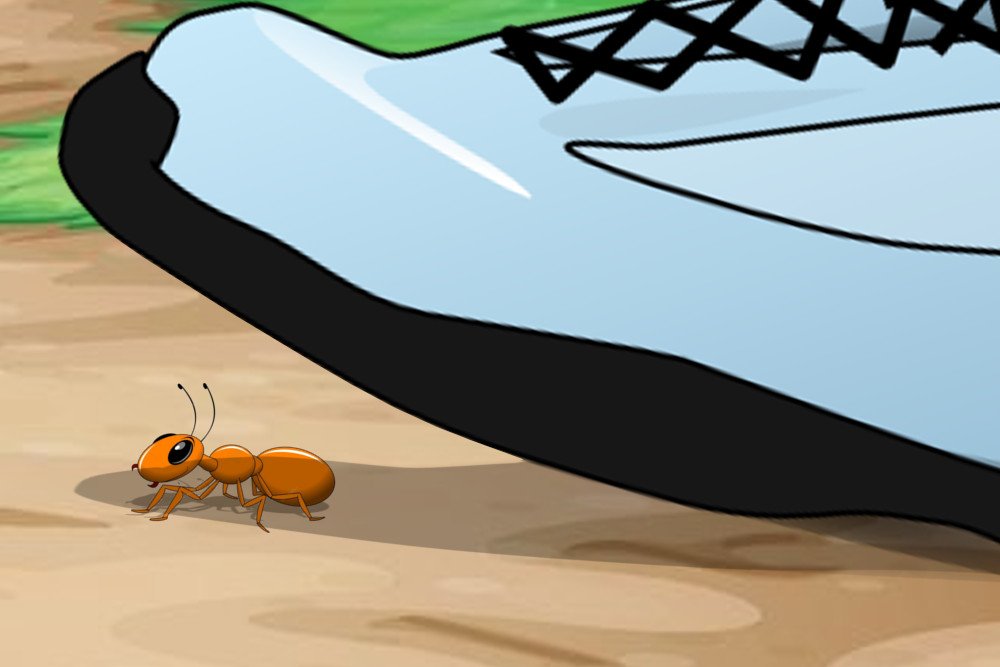
It was a night much like this one, still and quiet except for the rustling of leaves from the first true breezes of fall. A glassy sheen leaned in through fluttering window curtains as the light of a nearly full moon casts broken shadows across the rooms where a family lay in peaceful slumber, blissfully unaware of what was creeping ever closer.
Silently, the unknown presence moved through the family’s home, chaotically searching for what it needed, ever-growing, its numbers dwarfing that of the family still asleep upstairs. If there had been a noise, a squeak, a groan, anything to alert to the family to the invasion that was taking place, they may have stood a chance, may not have been woken so terribly from dreams so sweet, but the creatures moving through the home, through the walls themselves were chillingly noiseless.
So the night passed with the creatures amassing a horde of untold numbers.
The next morning, in the time just before dawn, when the sky is still murky and the world hasn’t yet taken its proper shape, the youngest child creeps from their bed and steals downstairs alone. Their heart is racing from the thrill of sneaking through the empty halls, racing past any open doors till they get to the kitchen. Holding their breath, they hear their pulse hammering in their ears as they drop down and peer around the corner, hoping they are alone, terrified they are about to be caught. A loud “caw” from a crow on the patio sends them tumbling to the floor, heart nearly exploding with its frantic pace. But the emptiness of the kitchen has been verified; or so it seems.
Tiptoeing to the counter, they see the treasures they had sneaked down for: Halloween treats of all shapes and sizes. They open the container with a flinch as its plastic crackles in the stillness of the heavy morning air. Keeping surveillance on the room around them, they reach a hand in and grab the sugar cookie they had had their eye on since last night. Without looking, they bring the cookie up to their mouth, but before teeth can sink in, they catch a glimmer of movement out of the corner of their eye. They look all around, but no one is there. The hairs on the back of their neck stand up as they know that something is moving all around them, something they just can’t see. Inching away from the kitchen, they bring the cookie up to their mouth again. And that’s when they see it. The movement is coming from the cookie itself. Their heart stops. Suddenly there is a glint of movement by the sink, and on the wall next to their head; the whole kitchen seems to be undulating in the dim gray light. They throw the sugar cookie down and scream, running full-tilt up the stairs and away from the possessed kitchen.
As parents and siblings are roused to soothe the terrified child, the moving creatures, hundreds of tiny ghost ants that have built their nest in the cracks of the kitchen, gather around the discarded cookie, continuing the task of foraging it for food for the ever-expanding colony.

Why are they Called Ghost Ants?
Unlike the “zombie ant,” another classic Halloween-appropriate ant species, the ghost ant doesn’t get its common name from any trauma or behavioral characteristic; instead, it received a spooky name simply because of its semi-translucent and spectre-like appearance, which make it difficult to see, like a ghost.
What do Ghost Ants Look Like?
Ghost ants are extremely small, around 1/16” long, and the workers are monomorphic (they are all the same size). They have a dark brown head & thorax with a pale, nearly translucent, yellow/white abdomen, antennae, and legs. When their colony is disturbed they tend to move in rapid, erratic movements, though they can sometimes be found in the more orderly and linear trail common to other ant species.

Where are Ghost Ants Found?
Geographically, ghost ants are found primarily in warm regions, originating in the old world tropics of Asia or Africa, and spreading from there to places like Hawaii, the Caribbean islands, Florida, Texas, and various tropical areas around the world. Though they prefer warm climates, they have made their way as far north as Canada by sticking to indoor locations, particularly greenhouses.
Outdoors, ghost ants tend to make their nests in protected places in the soil, in crevices of dead tree branches, under stones, in leaf piles/debris, in/under logs, in flowerpots, and under loose tree bark.
Indoors, ghost ants will nest in just about any protected cavity they can find, such as cracks, spaces between books, wall voids, behind baseboards, between cabinets, and in the soil of potted plants. Given the inconspicuous choices of nesting sites, you might be more likely to encounter the ghost ants when they forage or trail to water sources; though, these tiny ants will often live up to their haunting name by keeping themselves hidden from view while on their expeditions by trailing under carpet edges and along electrical wires within wall voids.

What do Ghost Ants Eat?
In nature, ghost ants prefer a diet of the honeydew that aphids make, and will also consume other insects. When they are interacting with people, however, they are just like kids at Halloween, and prefer to feast on sweet foods (in the case of ghost ants this would consist of cereals, sweet cakes, syrup, and raw sugar). Yet, though they prefer sweet foods, they will also consume foods high in protein or grease; so virtually any food in your kitchen is a potential meal for a ghost ant.
Are Ghost Ants Dangerous?
On an individual level, ghost ants are not dangerous. They do not sting and very rarely bite. Their bite, if you were to encounter it, would likely go completely unnoticed as it would be extremely rare to cause any discomfort or pain, and it carries no health risks.
The primary concern around the safety of a ghost ant infestation is due to the numbers of ants that can join together in giant nest sites of thousands, or even millions of individual ants; they are an ant species known for being able to redistribute themselves quickly and having no issue with overlapping colonies. Not only is there a significant risk that these populous ants will contaminate food in your home, which could at best cost you the price of replacing the food, and at worst cause illness for you and your family, but there is also an ecological concern at play (as with most invasive species) that as their numbers grow, they drive away local species, which can adversely affect the balance of the ecosystem.

How do you Kill Ghost Ants?
If you have ever killed a ghost ant by squishing it, you almost certainly noticed the pungent odor that was emitted upon its death. Much like Odorous House Ants, ghost ants give off a coconut-like odor when crushed. This odor has led to the ants being called by a different name in Malaysia: “Corpse Ant,” another fitting Halloween moniker. Not that killing ants by hand via squishing would ever be the #1 recommended method, but in this case, you would particularly want to avoid doing it at all, or else end up stuck with an otherworldly odor.
Much like their namesake, ghost ants are difficult to exorcise from a home once they have possessed it. Part of the reason for the difficulty is that their colonies contain multiple queens, so when a contact insecticide is used, the highly mobile colony can simply move to a new area and suffer no long-term ill effects. As with most ants, the most effective method of treatment is via the use of targeted ant baits; however, with the diminutive size of these ants, it’s especially important to get the correct dosage and type of bait if you are to succeed in eliminating the entire colony, and not just the foraging ants. It’s also particularly important to know where to place the bait, since ghost ants are such good hiders and have erratic foraging behavior, this can be particularly tricky, and is where training and years of experience definitely pay off.
If you think you have a ghost ant infestation, the best way to get it eliminated is to have a licensed pest control technician out to evaluate and treat using targeted products designed to exorcise even these spooky pests from your property.

How can you Prevent Ghost Ants?
Given the difficulties in eliminating a ghost ant colony once one has been established, it’s highly recommended to invest in a bit of preventative efforts to keep your home from becoming haunted.
- Keep shrubbery and tree branches trimmed away from your home
- Eliminate any leaf litter and yard debris around your home
- Store firewood or piles of bricks at least 20’ from your home
- Keep mulch (in landscaping) 12” from foundation and less than 2” thick
- Make sure your sprinklers don’t directly spray the foundation
- Remove any moisture sources from around your home
- Seal up any exterior cracks on your home
- Stay
vigilant and if you suspect ghost ant activity, do an inspection
- Inside: check all plumbing areas (sinks, toilets, tubs, etc.), carpet edges, around windows & doors, & electrical outlets (especially in the kitchen & bathroom)
- Outside: check along foundation walls & sidewalks, turn over any stones, bricks, logs, debris, etc. on the ground
Don’t let this Halloween become a stressful story of ghost ant haunting; if you think you are having a pest problem, call Mid-Cities Pest Control to help you get it eliminated quickly so you can get back to the fun of costumes, decorations, pumpkin carving, and bone-chilling frights, and make the only ghosts on your mind the spectral visages that dominate this holiday season.
Additional Resources:
“Ghost Ant, Tapinoma melanocephalum” – Urban and Structural Entomology Program at Texas A&M University
“Ghost Ant” – Texas Invasive Species Institute
“Ghost Ants” – PestWorld.org
Author Bio: Alissa Breach has been gaining knowledge and experience around pest control concerns over the last 10 years while working for Mid-Cities Pest Control. She has a creative writing BA from UW-Madison and is always pursuing new and interesting writing projects.




